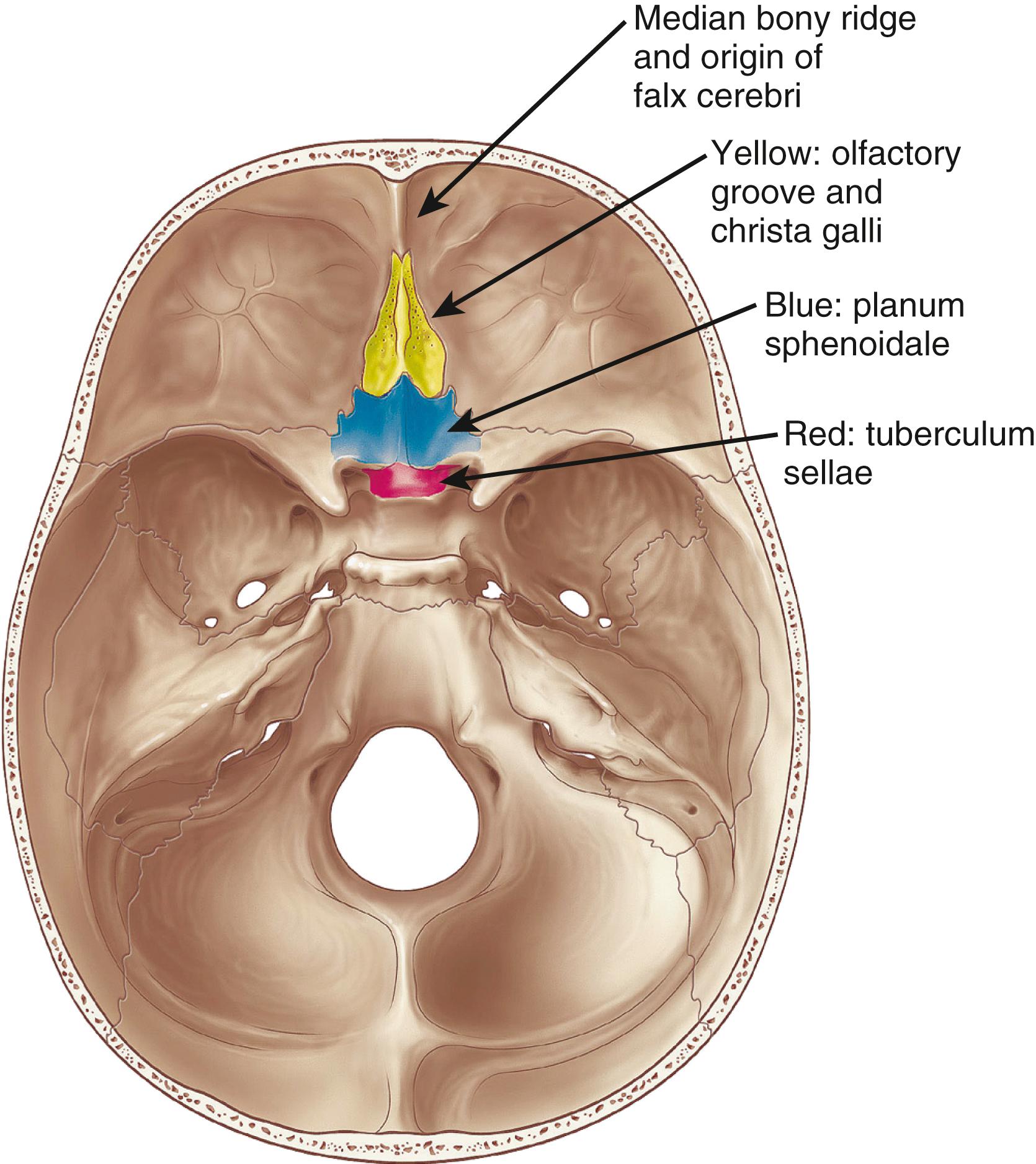Physical Address
304 North Cardinal St.
Dorchester Center, MA 02124
We are very grateful to Marc Matthes, M.Sc., for helping with the creation of Figs. 25.8–25.14 .
Meningiomas arising in the midline of the anterior fossa are generally separated into the more rostral olfactory groove meningiomas and the more dorsal planum sphenoidale and tuberculum sellae meningiomas (TSM). Planum sphenoidale/TSM occur at similar rates as olfactory groove meningiomas in our series of meningiomas, with both locations presenting less than 6% of all intracranial meningiomas but 21% of the anterior skull base meningiomas. Olfactory groove meningiomas arise over the cribriform plate of the ethmoid bone and the area of the fronto-sphenoid suture. These tumors may grow symmetrically around the crista galli or extend predominantly to one side and may involve any part of the planum of the sphenoid bone. Planum sphenoidale/TSM arise from the roof of the sphenoid sinus and the tuberculum sellae, which is an area between the optic nerves and anterior clinoid processes. Posteriorly and medially to the optic foramen, the anterior clinoid process attaches to the tentorium cerebelli, which are frequently overgrown by the tumors, as are the posteriorly located dural folds of the sella turcica and the lateral adjacent cavernous sinus ( Fig. 25.1 ).

Whereas planum sphenoidale meningiomas usually push the optic nerves dorsally and caudally, tuberculum sellae meningiomas lead to an upward bulging of these structures. Both entities might grow between, around, and beyond the optic nerves. Branches of the ethmoidal, meningeal, and ophthalmic arteries enter through the midline of the base of the skull and constitute the primary blood supply of those tumors. In smaller tumors, the A2 segments of the anterior cerebral arteries are usually not involved in the tumor capsule, but are separated from the tumor by a rim of cerebral tissue and arachnoid. However, in large tumors, these and additional segments like the frontopolar or other small branches originating from the anterior cerebral arteries may be adherent to the posterior and superior tumor capsule.
The olfactory nerves are either displaced laterally on the lower surface of the tumor or adherent, compressed, or even not visible while diffusely spread around the tumor capsule. Once the olfactory nerves are compressed by large tumors or even tightly adherent to the tumor capsule, it is difficult to preserve them, and it becomes almost impossible when the tumor has a broad attachment to the dura and infiltrates adjacent, often hypertrophic bone.
Olfactory groove meningiomas have a gradual and slow onset of symptoms and are difficult to localize neurotopically. Personality changes, such as apathy and akinesia, occurred in our series in up to 13% of patients. Other common symptoms include headache and inferior visual deficits. The Foster-Kennedy syndrome of unilateral optic atrophy and contralateral papilledema, although originally described in olfactory groove meningiomas, occurred in only a small number of patients.
In our own series, smelling disorders up to anosmia were apparent in 64.5%, but they were only diagnosed during the routine preoperative workup. Only 7.1% were completely anosmic preoperatively. In Cushing’s series, the sense of smell was the primary symptom in only three of the 29 patients. ,
Planum sphenoidale and TSM presented more frequently with visual pathway symptoms than olfactory groove meningiomas, such as acute vision loss or bitemporal hemianopia.
MRI represents the standard diagnostic means for evaluation of such lesions because it can delineate the mass effect and the relationship to other important structures, such as the optic nerves, the anterior cerebral arteries, and the frontal lobes. However, cranial computer-tomography (CT) and angiography are important adjuncts if the destruction of the anterior skull base, infiltration of the ethmoid bone, the relationship of the major vessels, and the vascular supply are of interest. Hyperostosis of the adjacent skull base is a common feature. Rarely, the tumor appears calcified. On T1-weighted MR images, the tumor is of equivalent signal intensity compared to the surrounding brain, and T2-weighted MR imaging reveals that the tumor signal is slightly increased compared with normal brain tissue, but less than that of cerebrospinal fluid. Fluid-attenuated inversion recovery and T2-weighted MR imaging highlights surrounding edema. With administration of gadolinium contrast medium, MR imaging demonstrates homogeneous tumor enhancement. It is crucial to analyze the relationship of the optic nerves and anterior cerebral arteries to the tumor capsule. Modern imaging tools easily facilitate the coregistration of many imaging modalities to visualize the tumor from any angle and to virtually plan the operation.
In recent years, angiography is not generally indicated unless embolization is planned. However, one should be aware of a considerable rate of hemorrhagic and ischemic complications when using small particles for embolization.
As the majority of meningiomas are benign well-circumscribed extra-axial tumors, complete surgical removal, including resection of infiltrated dura or removal of infiltrated bone, should be the primary goal in most instances. However, when tumors are firmly attached to the anterior vessels or the optic chiasm, a complete removal might constitute a high risk for damage to those structures. In these cases, a small piece of adherent capsule might remain and should be controlled by periodic MRI scans. Upon recurrence, reoperation and adjuvant radiation therapy may be considered.
Surgical approaches have become more focused and smaller over the last decades. Larger craniotomies do not necessarily provide better anatomical perception of the surgical field. More importantly, the extensive analysis of preoperative imaging reduces unnecessary exposition of the brain. With the advent of modern optics, endoscopy-assisted approaches and purely endoscopic procedures have improved the surgical armamentarium and replaced more conventional craniotomies. However, even the most extensive approaches should remain in our armamentarium.
Become a Clinical Tree membership for Full access and enjoy Unlimited articles
If you are a member. Log in here